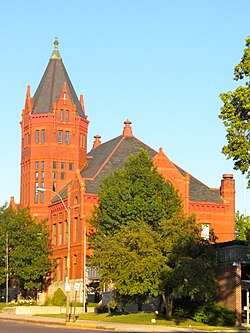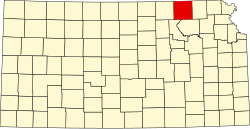History
The Oregon Trail crosses Marshall County. The infamous Donner Reed Party rested along the banks of the Big Blue river and lost one of its members, Sarah Keyes, who is still buried at Alcove Springs (located outside of Marysville). Many documented pioneer bodies are buried surrounding Alcove Springs.
In 1849 Francis James Marshall, from Weston, Missouri, came to Marshall County and established a ferry service on the Big Blue River at "Independence Crossing." A few years later Francis Marshall decided to stay on in Marshall County and make it his home. He moved his ferry business to an upper crossing now known as Marysville (the city is named after Marshall's own wife Mary). [4]
On May 30, 1879, the "Irving, Kansas Tornado" passed through Marshall County. This tornado measured F4 on the Fujita scale and had a damage path 800 yards (730 m) wide and 100 miles (160 km) long. Eighteen people were killed and sixty were injured. [5]
The Marshall County Historical Society resides in the county's historic courthouse, which is now a museum and research library.
Demographics
Historical population| Census | Pop. | Note | %± |
|---|
| 1860 | 2,280 | | — |
|---|
| 1870 | 6,901 | | 202.7% |
|---|
| 1880 | 16,186 | | 134.5% |
|---|
| 1890 | 23,912 | | 47.7% |
|---|
| 1900 | 24,355 | | 1.9% |
|---|
| 1910 | 23,880 | | −2.0% |
|---|
| 1920 | 22,730 | | −4.8% |
|---|
| 1930 | 23,056 | | 1.4% |
|---|
| 1940 | 20,986 | | −9.0% |
|---|
| 1950 | 17,926 | | −14.6% |
|---|
| 1960 | 15,598 | | −13.0% |
|---|
| 1970 | 13,139 | | −15.8% |
|---|
| 1980 | 12,787 | | −2.7% |
|---|
| 1990 | 11,705 | | −8.5% |
|---|
| 2000 | 10,965 | | −6.3% |
|---|
| 2010 | 10,117 | | −7.7% |
|---|
| 2020 | 10,038 | | −0.8% |
|---|
| 2023 (est.) | 9,933 | [7] | −1.0% |
|---|
|
As of the census [12] of 2000, there were 10,965 people, 4,458 households, and 3,026 families residing in the county. The population density was 12 people per square mile (4.6 people/km2). There were 4,999 housing units at an average density of 6 per square mile (2.3/km2). The racial makeup of the county was 98.14% White, 0.23% Black or African American, 0.36% Native American, 0.19% Asian, 0.02% Pacific Islander, 0.26% from other races, and 0.80% from two or more races. 0.76% of the population were Hispanic or Latino of any race.
There were 4,458 households, out of which 30.20% had children under the age of 18 living with them, 59.70% were married couples living together, 5.40% had a female householder with no husband present, and 32.10% were non-families. 29.50% of all households were made up of individuals, and 17.00% had someone living alone who was 65 years of age or older. The average household size was 2.40 and the average family size was 2.98.
In the county, the population was spread out, with 25.00% under the age of 18, 6.60% from 18 to 24, 23.60% from 25 to 44, 22.80% from 45 to 64, and 22.00% who were 65 years of age or older. The median age was 42 years. For every 100 females there were 96.80 males. For every 100 females age 18 and over, there were 94.00 males.
The median income for a household in the county was $32,089, and the median income for a family was $39,705. Males had a median income of $28,361 versus $19,006 for females. The per capita income for the county was $17,090. About 6.40% of families and 9.20% of the population were below the poverty line, including 9.60% of those under age 18 and 9.10% of those age 65 or over.
This page is based on this
Wikipedia article Text is available under the
CC BY-SA 4.0 license; additional terms may apply.
Images, videos and audio are available under their respective licenses.




